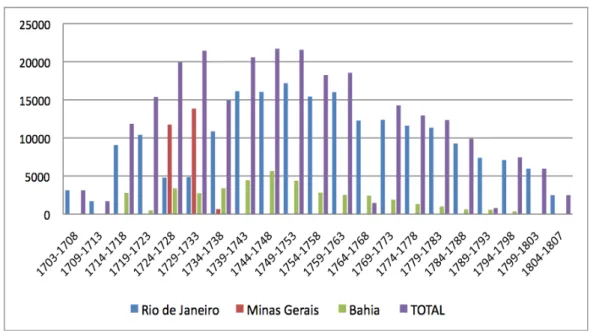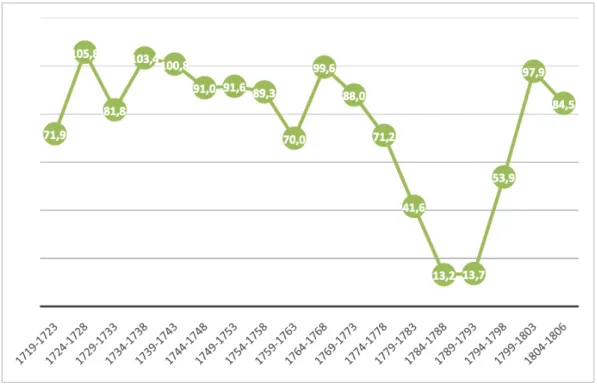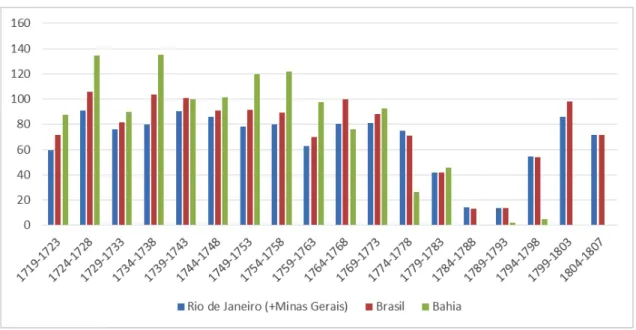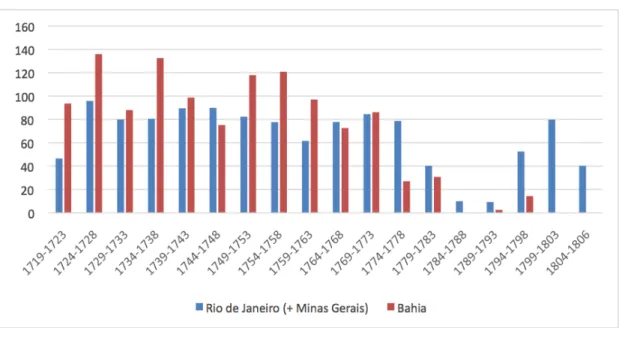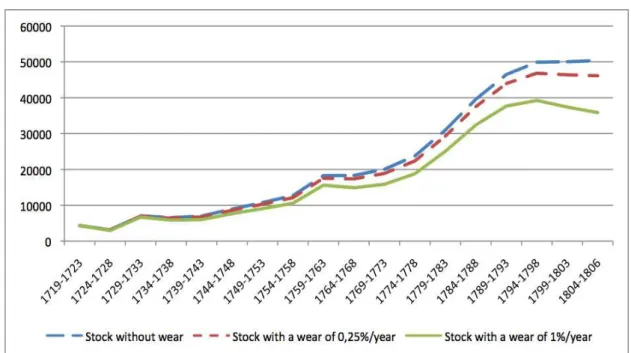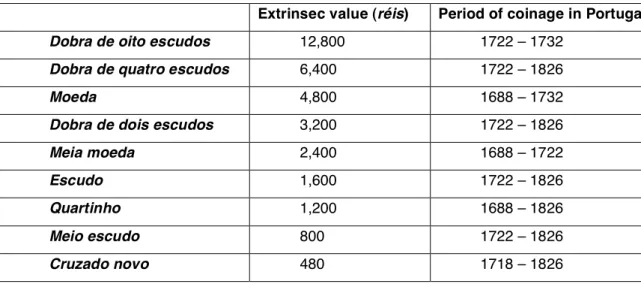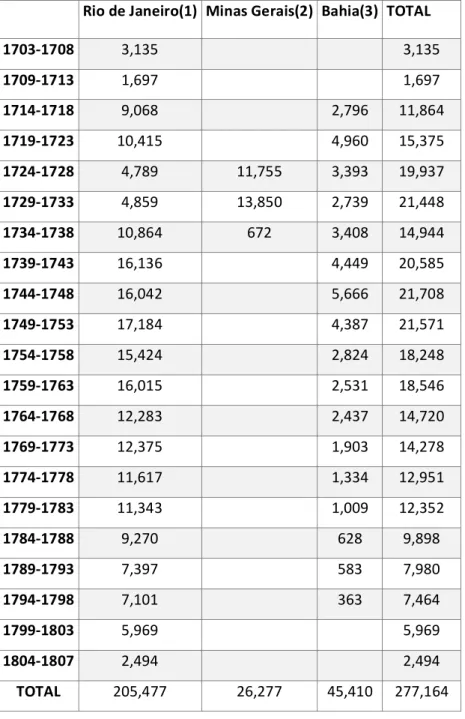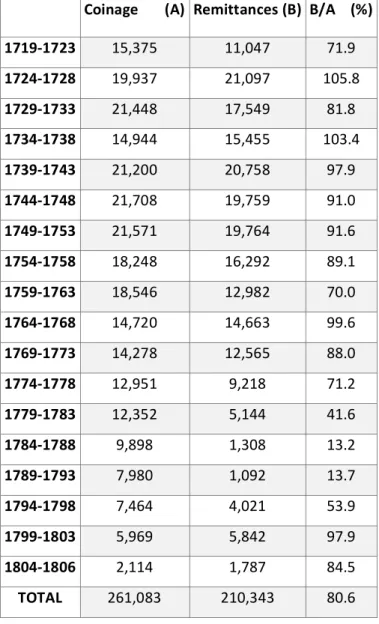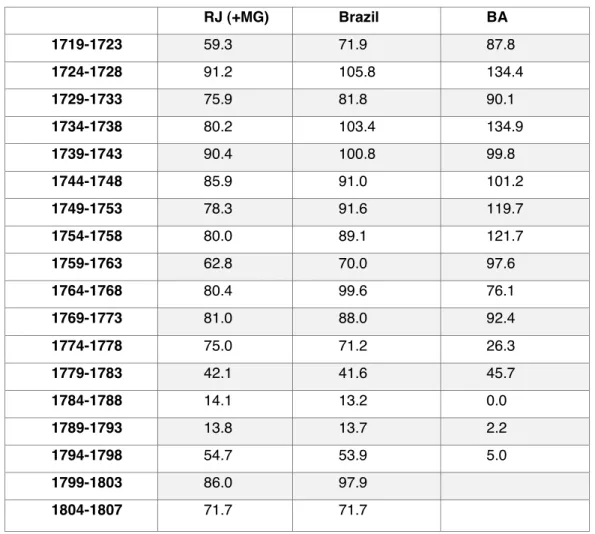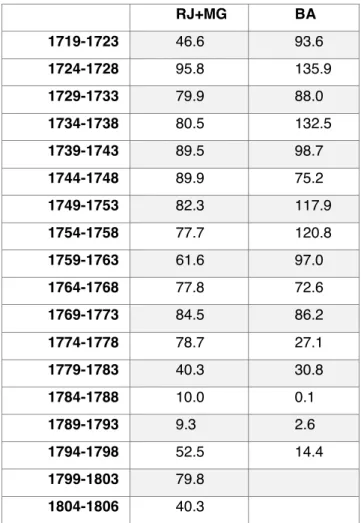Série Documentos de Trabalho
Working Papers Series
ISSN 2183-1785
Instituto Superior de Economia e Gestão
Universidade de Lisboa
Lisboa – 2015
Production, Supply and Circulation of
'National' Gold Coins in Brazil
(1720-1807)
Fernando Cerqueira Lima
Rita Martins de Sousa
Production, Supply and Circulation of 'National' Gold
Coins in Brazil (1720-1807)
Fernando Cerqueira Lima*
(Institute of Economics of the Federal University of Rio de Janeiro/UFRJ)
Rita Martins de Sousa
(CSG/GHES/ Lisbon School of Economics and Management-ISEG / UL)
fcarlosgreenhalgh@gmail.com
martins@iseg.ulisboa.pt
Abstract
Based on the hypotheses that Brazil was not merely an economy that exported precious metals
and that there was a relative expansion of the domestic market, in this paper we assess the
production, supply and circulation of ʻnationalʼ gold coins in Brazil in the 18th century. New estimates
are provided of the production of these gold coins at the mints of Rio de Janeiro, Bahia and Minas
Gerais. Comparing the values of the coinage with remittances to Lisbon, the first half of the 18th
century reveals a more stable conjuncture than was found in the second half. This latter period shows
fluctuations that were expressed in the faster growth of the supply despite the fall that took place in
the production/coinage of gold. Our conclusions question the historiographical theses about the
shortage of currency in Brazil throughout the 18th century. The growth of the economy from the last
quarter of the century onwards implied an increase in the demand for money, which it proved possible
to meet through the production of ʻnationalʼ gold coins.
JEL codes
: N13; N23; N43
Keywords
: Brazilian Mint Houses; Brazilian gold; Money Supply
Plan
1. Introduction
2. Money in colonial Brazil: a brief literature survey
3. Production of ‘national’ coins in Brazil
3.1. The monetary system
3.2. Coinages in Brazil (1703-1807): new estimates
4. Difference between coinages and remittances of ‘national’ gold coins
5. Stock and circulation of ‘national’ gold coins in Brazil
1. Introduction
The most recent historiography has reassessed the monetary aspects of relations between
Brazil and Portugal (Carrara, 2010b; Costa, Rocha, Sousa, 2013), with one of its conclusions pointing
to the existence of complementarity in the production of metallic money. In the 18th century, the mints
opened in Brazil produced not only provincial coins, but also gold coins destined for circulation in
Portugal, the so-called ʻnationalʼ currency. In turn, the Lisbon Mint also produced provincial coins
destined for circulation on the other side of the Atlantic. Such complementarity also derived from the
recipients of the issues of gold coins: in Rio de Janeiro, Minas Gerais and Bahia, the national gold
coins that were produced were destined for private economic agents, who then sent them to Portugal
in the shipsʼ coffers, while in Lisbon gold bullion and gold dust were mainly received by the State.
Between 1720 and 1807, 557 tons (271,000 contos) of gold arrived in the port of Lisbon,
corresponding to 73% of the total gold production in the period between 1721 and 1799. Of these
imports, 78% were destined for private economic agents, while 22% were net tax revenues collected
by the State. While this conclusion highlights the gap between the production and the remittances of
gold, the systematic calculation of all the gold coined at the Brazilian mints needs to be reassessed.
This will make it possible to understand whether, during the 18th century, all the coins minted in Brazil
were or were not shipped to Lisbon. A comparison of these three variables – production, coinages,
and remittances – also enables us to find an explanation for the gap between coinages and
remittances.
In turn, in Brazilian historiography, there is now greater consensus about the view that, in the
18th century, Brazil was not merely an export economy, but that it also expanded its domestic trade1.
Recently, the debate about the relationship between mining, currency and the domestic market has
extended the discussions that had previously taken place in relation to the former Spanish colonies,
such as Potosi, Córdoba, Paraguay and Buenos Aires (Assadourian, 1982; Gelman, 1984 and 1993;
Romano, 1998; Ibarra, 1999). The debate has tended to become polarised into a discussion of the
nature of these areas that produced precious metals: were they natural economies or monetary
economies? (Johnson, 1973; Carrara, 2010a)
Based on the hypotheses that, in the 18th century, Brazil was not merely an economy that
exported precious metals and that there was a relative expansion of the domestic market, the main
research question is whether this market was or was not “irrigated” by the circulation of metallic
money. Quantifying the currency stock that was available in Brazil might help to solve this question.
Determining the total amount of currency produced at the mints of Portuguese America, and
subtracting from this the total amount of coinages sent to Portugal would be a first step.
1
The aim of this paper is to assess the production and stock of national gold coins in Brazil in the
18th century, hoping in this way to contribute to the discussion of the monetarisation process. Writing,
in his classical study A Política Monetária do Brasil, about the history of money in Brazil in the period
prior to the arrival of the Royal Family in Rio de Janeiro in 1808, Pandiá Calógeras asked: “What
amounts had been coined? What amounts were in circulation? These problems are impossible for us
to solve, given the current state of our knowledge” (Calógeras, 1960, p. 15). This paper seeks to
provide an answer to these questions. Although recognising that part of the currency was also in the
form of provincial coins, the authors of this paper chose not to contemplate this particular problematics
here, since they considered that the difference between the amounts of national and provincial coins
that were in circulation does not call their conclusions into question and raises different theoretical
problems (Fantacci, 2005).
In the first section, a brief summary will be made of the historiographical debate about the role
of currency in the colonial period. The aim will be to demonstrate how the various approaches have
tended to focus on contradictory theses: sometimes, what is most noticeable is the absence of a demand for money, and, at other times, its shortage. In the second section, a description is made of
the legal design of the monetary system, and new estimates are provided of the production of national
gold coins at the mints of Rio de Janeiro, Bahia and Minas Gerais. The continuing permanence of
national gold coins in Brazil makes it possible to question their destination, and, furthermore, serves to
provide a first step in the regional analysis, establishing a difference between Rio de Janeiro and
Bahia. This will be the target of section 3. The fourth section is devoted to a discussion of the
calculation of the stock of national gold currency in Brazil, corroborating the information available from
that time about its circulation. The conclusion is that at least part of this national gold currency
remained in Brazil, helping to oil the domestic market.
2. Money in colonial Brazil: a brief literature survey
The most common approach to monetary questions in the colonial period is based on the idea
that there was almost no circulation of metallic money. Not even the great production of gold (and gold
coins) in the 18th century would have changed this picture, because, in a slave-based economy,
based on the plantation system, with self-sufficient economic units geared exclusively to the external
market, the absence of currency would not interfere with its economic performance. From the
mid-18th century onwards, the development of trade, especially in the Rio de Janeiro region, would have
led to a hierarchical system of credit. This line of reasoning leads one to conclude that inside the
colony itself there would be no demand for money for transaction purposes, since these could be
carried out without the need for monetary resources.
A survey of some of the authors who have written and reflected on Brazilian economic history
situation prevalent at the end of the colonial period, states that “in a land where industries, except for
the production of raw cotton cloth, were prohibited, where the main activity was concentrated in
agriculture, and where foreign trade was in the hands of Portugal, the money stock would have been
limited, just as the needs for currency would also have been limited” (Simonsen, 1941, vol. 2, p. 261).
This makes it explicit that there would not have been any demand for money; consequently, it does
not make sense to talk about a shortage of money.
Following the same line of thought, Celso Furtado, in his book Formação Econômica do Brasil,
published in 1959, considers that production was basically destined for export, so that the monetary
flow was established between the production unit and the external market. In the event of an external
crisis, the adjustment was made automatically. By reducing income, the fall in exports also implied a
reduction in the imports not only of consumer goods, but also of capital goods and labour, giving rise
to a (frequently lengthy) process of decline. It should be added that there would be no demand for
money for transactions inside the colony, for the only “multiplier effect” caused by the sugar industry
would be related with cattle farming, which would absorb no more than 5% of the monetary income
generated by sugar exports.
In turn, when writing about the Brazilian export economy, Caio Prado Júnior (1942) assumed:
“the general nature of Brazilian colonisation… is that of a colony destined to
provide European trade with some tropical commodities of great economic
importance. It is for this purpose that it was created. … Anything more that exists
therein, and which, in fact, will always be of limited value, is subsidiary and destined
solely to support the achievement of that essential aim. Also included here is the
subsistence economy….” (Prado Jr., 1942, p. 41).
The author describes the various secondary activities at length, highlighting the “agricultural
renaissance” that took place from the 1770s onwards and mentioning the existence of coastal trade to
supply the urban centres. But he reveals almost nothing about the forms (means) of payment.
Among the authors who sought to analyse the monetary questions more directly, D.T. Vieira
(1985) explains, in a frequently quoted passage, why there was little actual need for cash, in view of
the economic and social characteristics of Brazil at that time:
“[The] producer did not need cash, because the payment of work was limited to the maintenance of the slave (...). The stewards and skilled workers mainly received their payments in natura. (…) Money, existing in small quantities,
was only accumulated in the most important cities, and even there it was only in the
tended to hoard it rather than cause it to circulate. (Vieira, 1985, p. 350, our
emphasis)
The problematics of the scarcity of currency was also considered by Noya Pinto (1979), who
highlights the importance of mining on the supply and demand for money. This author considers that
until the appearance of gold, the circulation of currency in Brazil was reduced in scale, being limited by
the small amounts of coins minted in Lisbon and sent to the colonies. To overcome this shortage, the
colonists resorted either to trading with the use of native products transformed into currency, such as
tobacco and cotton, or to trading with the Spanish colonies, especially Buenos Aires, where they
acquired silver coins. This circumstance meant that a system of trade in natura remained dominant,
stimulating a closed internal economy that supplied itself, in which prices changed little due to the
weak mechanism of supply and demand. In the 18th century, however, gold altered this situation.
Firstly, gold in the form of dust, and then later in the form of coins produced at the various mints set up
in Brazil, began to circulate in the Brazilian domestic market, leading to a rise in prices resulting from
the huge demand and limited supply. Mining activity, which was accompanied by urban and
demographic growth, created conditions for the formation – for the first time in the history of Brazil – of
an internal market stimulated by the increased amount of currency in circulation and the greater
purchase power of the colony in general, and the mining regions in particular. Thus, for Noya Pinto,
the greater supply of currency (metallic money and gold dust) contributed to the development of the
internal market. The exception to this picture was the region of Bahia, where the demand for money
existed, but the supply was insufficient to meet it, at least until the 1730s.
More recently, Jucá Sampaio (2002) reached a number of conclusions about the shortage of
metallic currency in some regions of Brazil. Studies based on inventories serve him as an argument.
He considered credit not as an option for postponing the settlement of payments in keeping with a
mercantile logic, but as a consequence of that shortage. According to Jucá, money travelled in just
one direction, namely from the mining areas to Rio de Janeiro, where a merchant elite controlled its
flows; in the daily life of Rio society, money was scarce. Like Fragoso (1992) and Fragoso &
Florentino (1993), Jucá considers that the shortage of currency led to the establishment of hierarchical
chains of credit (indebtedness).
Therefore, according to these authors the questions related both with the supply and demand of
money would not have been important to analyze the Brazilian economy in the colonial period. The
most common conclusions point to the absence of currency in most regions, together with its
geographical and social concentration. But is it possible to continue to defend this picture of an
3. Production of ʻnationalʼ coins in Brazil
3.1. The monetary system
At the beginning of the 18th century, the monetary system in Portuguese America was a bimetallic
one. The unit of account was the real and, besides metallic money (gold, silver and copper), the
means of payment included such commodities as cotton, sugar and gold dust. While cotton was a
means of exchange in the State of Maranhão and Grão-Pará, gold dust circulated, above all, in the
mining regions (Antonil, 2001). The ratio between the settlement of exchanges in commodities or in
“cash” had changed in comparison with the previous century. Cash payments became more common,
or, in other words, metallic money became not only the means of payment, but also the predominant
means of exchange. In this sense, the shortage of metallic money might have represented an
obstacle to trade in general, including the business of the State. However, if metallic money is seen to
have circulated in sufficient quantities to meet the demand for money for transaction purposes, then
this would strengthen the thesis of the expansion of the internal market throughout the 18th century.
As far as metallic money is concerned, two types of coins were produced both at the Lisbon
Mint, and at the mints set up in Brazil: national gold coins, intended for circulation in Portugal, and
provincial coins, made of gold, silver and copper, which were to be used exclusively as legal tender in
the Portuguese American territory. Thus, in the case of colonial Brazil, not only was it a bimetallic
system, but it was also a system with complementary coins in circulation (Fantacci, 2005). However,
as will be demonstrated in Section 3, the so-called ʻnational gold coinsʼ also circulated in Brazil. Let
us, then, assess their production at the mints opened by the Portuguese Crown in Brazil.
3.2. Coinages in Brazil (1703-1807): new estimates
The large-scale mining of gold in Brazil from the late 17th century onwards brought profound
changes to the coinage policy. It was decided to reopen the Rio de Janeiro Mint (CMRJ) in 1703 and
then, in 1714, the Bahia Mint (CMBA), which remained in operation until 1832. A third mint was
established in Vila Rica (CMVR), between 1724 and 1734. The initial idea was to mint exclusively
“national” coins, with the same intrinsic and extrinsic value as those produced at the Lisbon Mint
(Table 1). With this measure, the metropolitan authorities sought to prevent the smuggling of gold
dust, for this diminished the Crownʼs revenue.
Historians interested in calculating the quantity of gold transferred from Brazil to Europe have
investigated the total amounts produced at the Brazilian mints. Soetbeer (1880) presents annual data
regarding the marks of gold entering the Rio de Janeiro mint in the period 1703-1810. These data are
coherent with the information about the coinages made in Rio, as stated in documents from the
second half of the 19th century. For example, in 1862, Candido de Azeredo Coutinho, the director of
when the CMVR was in operation. This average annual value for the period 1725-1733 is confirmed
by Soetbeerʼs data. Also, according to Azeredo Coutinho, 1755 was the year of greatest production,
with production in 1780 having been 2,550 contos lower. According to Soetbeerʼs data, the CMRJ
produced 4,844 contos in national coins in 1755 (the highest value in his series) and 2,297 contos in
1780, or, in other words, 2,547 contos less. The numbers presented by Soetbeer also match the
annual values presented by the Conde de Resende for the period 1768-1796.
The table showing the production of the CMRJ for five-year periods, presented by Michel
Morineau (1985), is based on Soetbeerʼs data, even though they do not always coincide with one
another.
The coinage of the Vila Rica Mint (CMVR) was originally presented by Charles Boxer (1962).
As in the case of Soetbeer, his data show the amount of marks that entered that mint each year.
A synthesis of the information provided by Morineau and Boxer has been made by Costa,
Rocha, Sousa (2013), aggregating the values for some years of the 1760s at the Bahia Mint. In the
case of the CMVR, in order to convert marks (weight) into contos de réis (unit of account), the value in
marks was divided by 10 and multiplied by 1.024.
In this section, the data that have been systematised so far are completed and consolidated.
Figure 1 and Table 2 (see the appendix) present the data for the production of national gold coins over
five-year periods by the three mints operating in Brazil in the 18th century.
Figure 1 – Production of ʻNationalʼ Gold Coins (1703-1806) (in contos)
Sources: See Table 2 (Appendix)
It can be concluded that for the group of mints as a whole, the coinages were high between
1724 and 1763, and that they remained significant in size until the late 1780s. It should be noted,
1750s onwards, since, until then, the amounts produced at the Bahia Mint remained relatively stable,
with its coinages amounting to roughly one third of those of the CMRJ. It can also be concluded that,
during the ten years in which it was in operation, the CMVR produced more than half of the total
amount of coins produced in the colony, and that the beginning of its activity in 1724 greatly reduced
the coinages made both at the CMRJ and at the Bahia Mint. For the period as a whole between 1703
and 1807, the CMRJ was responsible for 74.1% of the total of national coins minted in Brazil.
4. Difference between coinages and remittances of national gold coins
While the national gold coins were destined for circulation in Portugal, not all of them reached
there. The difference between the coinages of national gold coins produced at the Brazilian mints and
their subsequent remittances was one of the conclusions already highlighted in Costa, Rocha, Sousa
(2013). However, the new data make it possible to reassess this difference. Figure 2 and Table 3 (see
the Appendix) organize the data regarding the coinages of national gold coins in comparison with their
actual remittances on board ships crossing the Atlantic in the period between 1720 and 1807.
Figure 2 – Ratio of remittances to coinages of national gold coins (1719-1806) (in %)
Sources: See Table 3 (Appendix)
We conclude that there were two five-year periods when remittances were higher than
period as a whole, there was a difference of roughly 20%. Secondly, there were certain
conjunctures that affected the ratio between the two variables. There was a fall in remittances
beginning in the 1740s, followed by a slight rise between 1764 and 1773, and then a sharp
fall from the late 1770s onwards. Remittances rose once again at the end of the century and
the beginning of the next one.
This behaviour of the two variables raises at least two questions. First of all, what
justifies the differences between coinages and remittances? And, on the other hand, what is
the meaning of the conjunctures detected?
As has already been demonstrated in previous research, 91% of the coins shipped
were sent to private agents and only 9% were destined for the State (Costa, Rocha, Sousa,
2013, pp. 72-82). Of these shipments, 80% were related with commercial activities, while the
remainder was equivalent to what today is referred to as unilateral transfers and the
remuneration of services.
Considering the proportions that have been calculated, it can therefore be said that the
20% difference can be explained by the fact that the shipments of these national gold coins
minted in Brazil were not conducted in an official manner. However, did the fact that the
remittances were not official mean that they were shipped in such a way as to avoid payment
of the 1% import duty levied at the Lisbon Mint, the place where these shipments were
delivered? Or, on the contrary, did it mean that these national gold coins remained in
Brazilian territory? The information provided by the governors of Rio de Janeiro, Bahia and
Maranhão point to their circulation in domestic transactions (see Section 4). In this sense,
some explanatory hypotheses may be put forward to account for the fall in legal remittances
of gold coins from the 1740s onwards.
First of all, smuggling was, as ever, the prime suspect, but this activity would be more
profitable in the case of gold dust. Simple fraud was, certainly, part of the problem, but the
fact that gold dust had a lower nominal value than that of the (international) market was more
important, as stressed by some contemporaries. In commenting on the different values
officially attributed to gold dust, Eschwege summarises the argument as follows: “By virtue of
this arbitrary process (…), the mistake was made of never attributing to it the real exchange
value, which resulted in a loss of many millions for the Crown. In fact, as gold had a much
lower commercial value than the one attributed to it by the government, it was natural that
smuggling should appear as such an attractive proposition, for, not only were the 20% of the one-fifth tax saved, but, furthermore, a high premium was gained” (Eschwege, 1944, vol. 1, pp. 247-248, our emphasis).
The second reason that can be suggested is the trade taking place with Portugal. First
of all, because Brazilian exports increased, in particular, with the “agricultural renaissance”
beginning in the 1770s (Ferlini, 2003, pp. 128-133), and imports fell (Costa, Rocha, Sousa,
transfers”, the imports paid for with other merchandise (barter) helped to reduce remittances.
Exports paid for in cash did not reduce remittances (in the short term, they may even have
increased, if the money was used to pay off debts, etc.). Therefore, the effects of foreign
trade on remittances depended both on the trade balances and the way in which payments
were made (for example, the greater use made of bills of exchange could explain the fall in
remittances).
Arbitration operations in the River Plate and Colónia do Sacramento region could also
explain the fall in remittances, since silver was highly valued at the time (Lima, 2013), but this
would, of course, be a silent effect, because, unlike gold, there are no records of its imports
into Lisbon (Sousa, 2012).
Another hypothesis is related with the probable increase in hoarding (or liquidity
preference). Gold coins completely fulfilled the function of offering reserves of universal
value, all the more so because, at the time, the absence of a banking system or a capital
market did not allow for alternative forms of financial investment.
Finally, and perhaps the most important reason for not sending coins to the metropolis
was the increase in the demand for money(the demand for transactions in the colony) arising
from the growth in the population and in income, the diversification of production and the
expansion of intra and interregional trade (Fragoso, 1992; Lapa, 1994). Various payments
were necessarily made in cash (civil and naval construction) and there were individual and
institutional cash loans, urban and rural property investments, rental charges, etc. all paid for
in money. When the amounts were high, gold coins were used as they had a greater extrinsic
value. The increased demand for money without any increase in its supply might, in fact,
have generated situations in which there was a shortage of currency. In turn, the colonyʼs
economic and political growth must have motivated the reinvestment of part of the profits
from foreign trade in the colony itself (whether or not these were productive investments).
(Sampaio, 2002; Pesavento, 2012).
The aggregate data may conceal regional differences in the shipments. Thus, Figure 3
Figure 3 – Proportion of remittances in the coinage of national gold coins by geographical mints
(1719-1807) (in %)
Sources: See Table 4 (Appendix)
The distribution of the regional pattern of the proportion of remittances in the coinages at the
different mints shows the high percentage recorded between 1724 and 1733, arising from the
coinages at the Minas Mint and the shipment of these through the port of Rio de Janeiro. Comparing,
after this, Rio de Janeiro and Bahia, it can be seen that the latter mint shipped proportionally more
coins than the CMRJ until the 1760s. From the five-year period 1764-1768 onwards, Rio increased
and Bahia drastically reduced its remittances. Bahiaʼs links to the remittances of private agents may
explain the decrease in the importance of this mint, since, from 1750 onwards, there was a reduction
in the remittances sent by these agents to Lisbon (Costa, Rocha, Sousa, 2013). We continue to put
forward the research hypothesis that these remittances were linked more to agents located in the
north of Portugal, above all in Porto. The possibility of alternative areas of trade, namely with the east
of Europe, may have led some of these agents to operate in other geographical regions.
Figure 4 and Table 5 (see the Appendix) show the relationship between private remittances and
the income of the mints, with this latter variable having been calculated from the total coinage minus
Figure 4 – Proportion of coinage shipped by private agents in the income of the mints (in %)
Sources: See Table 5 (Appendix)
This strengthens the conclusion that private agents did not send all the national gold coins that
they received to Lisbon, especially those produced at the CMRJ. In Bahia, it was, above all, from the
five-year period of 1774-1778 onwards that this fall became particularly significant, for, until then,
shipments had included almost all the coins minted.
Since not all of the coins produced were sent to Lisbon, the difference could mean that
remittances were sent to the State. However, not only did the State absorb only 9% of the total
coinage made in Brazil (Costa, Rocha, Sousa, 2013), but also the policy of shipments to Portugal
changed in the course of the 18th century. In the first decades of the century, the tax revenue related
with gold (the “quinto” tax and the seigniorage) were supposed to be sent to the Court. In the case of
the seigniorage, despite this recommendation, an ever greater part of this was being used in Brazil.
From 1767 onwards, the whole revenue from the CMRJ was, quite probably, sent to the Royal
Treasury of the captaincy. For example, between 1719 and 1738, the seigniorage amounted in total to
3575 contos and remittances to 7876 contos, thus pointing to the sending of the seigniorage revenue
together with the revenue from other taxes. However, this was not the case in the last few decades of
the 18th century. In the period between 1780 and 1807, the revenue from seigniorage amounted to
2723 contos, whereas the remittances to the State only amounted to 2344 contos. The most probable
explanation for this would be the increase in the Stateʼs financial requirements, mainly with the
defense of the territory, which not only included the soldiersʼ pay, but also expenditure on fortifications.
In the 18th century, outside the mining regions, such payments could only be made in cash, or, in
5. Stock and circulation of ʻnationalʼ gold coins in Brazil
What has been said so far allows us to conclude that a significant percentage of the national
gold coins produced at the Brazilian mints remained in the colony. Based on this premise, a first
attempt can be made to calculate the money stock in Brazil, considering only legal operations. Stock
is not the same as circulation, with the difference between these two variables lying in the
phenomenon of hoarding. As was seen in the previous section, part of the national gold currency was
being hoarded.
The calculation of the stock of national gold coins in Brazil can be made by adapting the formula
proposed by Glassman and Redish (1985) as follows:
Stock of national gold coins (in Brazil) = Coinage at the mints of RJ, BA and
MG – Remittances of national coins to Portugal in commercial transactions or
unilateral transfers (State and private agents) + Brazilian exports received in national
currency + Transfers by private agents to Brazil – Losses through wear
The first two components of this formula (coinage and remittances) are known, and they are
undoubtedly the most determinant variables. The amount of illegal shipments, which include
smuggling and arbitrage operations, is not known, and it would represent a reduction in the money
stock. However, due to a lack of systematic data, neither the component ʻBrazilian exports received in
national currencyʼ nor ʻtransfers by private agents to Brazilʼ will be included. These amounts may not
be overvalued, for, in fact, both the data to be found in the Balances of Trade, as well as in some
documents from the period, show the existence of cash transfers from Lisbon to Brazil.
As far as the variable ʻlosses through wearʼ is concerned, the calculations contemplate a rate of
wear of both 0.25% per year and 1% per year, in keeping with the rate proposed and used in previous
studies (Glassman and Redish, 1985). Considering these two percentages makes it possible to
calculate a range of variation for the stock of national gold coins in Brazil with a difference of roughly
10,000 contos (see Table 6 in the Appendix).
But what is the initial value to be taken into account? The most exact calculation is only possible
from 1719 onwards, since the value of the remittances sent on the fleets was only recorded from 1720
onwards (Costa, Rocha, Sousa, 2013). However, there are some data available about the gold
imported to Lisbon as from 1713, before the beginning of a fleet system in 1720 (Lopes, 2001). The
consideration of these data makes it possible to calculate the value of gold arriving in Lisbon between
1713 and 1719 as amounting to 2,627 contos. However, this amount corresponds to gold bullion,
since there is almost no record of coins entering the country. Or, in other words, the roughly 16,700
contos worth of gold minted as national gold coins at the Rio de Janeiro and Bahia mints (see Table 2
in the Appendix) are not included in the data before 1720. In this sense, while this might be a possible
been explained. We therefore begin from a value of zero in 1719, since it is not possible to precisely
assess the amounts that remained in Brazilian territory.
The accumulated data give a picture of the balance of the monetary base, serving as a basis
from which other forms of means of exchange and payments might be created (bills of exchange,
paper-money, bank deposits, etc). In this case, the ratio between coinage and remittances is just a
first approximation for calculating the money stock, with the oscillations taking place in this ratio being
more relevant than absolute values (table 6 and Figure 5).
Figure 5 – Stock of ʻnational coinsʼ in Brazil (contos)
However, the absolute values reveal that the availability of metallic money in the colony, at least
in the second half of the 18th century (when the demand for money increased greatly), would not have
been an obstacle to the development of a “domestic market”, thus contradicting the notion that there
was a shortage of currency. In 1806, the amount was between 36,000 and 46,000 contos of gold
metallic money, which may point to the thesis put forward by Redish (1984), according to which, at the
beginning of the 19th century, in some colonial areas, the currency problem was a qualitative and not
a quantitative one.
A calculation of the value of the currency in Brazil at the beginning of the 19th century was
originally presented by Cândido José de Araújo Viana, in 1833, which, since then, has been quoted by
all authors. Viana estimated the total amount of metallic currency in circulation at 10,000 contos,
which included gold, silver and copper coins, 2/3 of which weregold. Therefore, this estimate is much
lower than the one that has just been calculated, all the more so if one considers that some of the gold
currency included in these calculations consisted of provincial coins. However, Vianaʼs estimates
cannot be strictly compared with our own, insofar as they referred to the money in circulation, whereas
Certain official statements from the time help to strengthen our conclusion about the
undervaluation of the amount indicated by Viana and generally upheld by other authors. An official
letter sent, in 1799, to Dom Rodrigo de Sousa Coutinho by the head of the Bahia Treasury, proposing
the issue of paper money, makes the following conjecture: “Supposing that at this Captaincy, at least
five million cruzados of metallic money – both national and provincial – are in circulation, the sum of
500 thousand cruzados in paper is one tenth of this amount…”. Thus, he estimated the amount of
metallic currency in the captaincy of Bahia alone to amount to two thousand contos.
Considering that the values shown in Table 6 (see the Appendix) would therefore be very close
to the total currency stock in Brazil, we can therefore begin to assess its significance by comparing it
first with Portugal.
Table 1 – Stock of national gold coins (nominal values)
Total stock of gold (contos) Stock of gold per capita (réis)
Brazil (1806) 35 855 – 46 126 9 796 – 12 603
Portugal (1806) 72 927 22 790
Sources: For the population of Brazil, the data provided by Mortara (1941, p. 43) were used. For the value of the stock of gold in Portugal, see
http://aquila4.iseg.ulisboa.pt/aquila/investigacao/ghes/investigacao/base-de-dados.
It should be noted that, in comparing the two stocks, for Portugal it is not just a question of the
coinages made at the Brazilian mints. The stock also includes the coinages made in Lisbon both for
private agents and for the State, as well as the exports arising from the negative trade balances with
foreign nations. Comparing the two stocks of gold, it can be concluded that between 30% and 40% of
the national gold coins would have been in Brazil at the beginning of the 19th century. In terms of the
money supply per capita, the degree of monetarisation of the Brazilian economy was roughly half of
that of the Portuguese economy. The different demographic and economic structures would account
for such differences. Therefore, the degree of monetarisation of the Brazilian economy calls into
question those theses that point to the absence of currency in slave-based economies.
Next, we shall compare the value obtained for Brazil with that obtained for Nova Granada, a
mining economy, and with England, an economy that was beginning its industrialisation process.
Table 2 – Stock of gold currency (minimal values)
Total stock (pounds)
Stock
per capita
(pounds)
Brazil (1806)
9,959,722 – 12,812,777
2.7 – 3.5
Nova Granada (1800)
691,778
0.74
England (1800)
51,000,000
5.5
Sources: For Nova Granada, see Moreno, 2013. For England, see Lindert, 1985. Note: Conversions – £1 = 0-0036 contos; 1 peso = 38 pence = £0.158 (McCusker, 1992)
Comparing the values of Table 2, it can be concluded that Brazil would be an economy that was
much more heavily monetarised than the former Spanish colony (roughly three times as much) and
had a degree of monetarisation that was closer to that of England (roughly one half). It should be
stressed that this degree of monetarisation tells us nothing either about the pattern of its distribution or
about the velocity of circulation of money. We are comparing economies with different levels of
financial development, with the degree of monetarisation in England also being explained by the
existence of banking institutions that increased the potential for the use of gold coins (monetary base).
As we have already stressed, calculating the currency stock does not mean that this was the
currency that was actually in circulation. However, some information provided by governors allows us
to observe the presence of national gold coins in Brazil, alongside provincial coins. This very fact can
be concluded from the information sent by the governor of Bahia to Dom Rodrigo de Sousa Coutinho,
and dated 1797: “For regular daily transactions, there are in circulation the provincial coins of this
captaincy… besides the half doubloons of six thousand and four hundred réis, which very frequently
circulate so well in trade.” These doubloons of 6$400 réis were included in the national currency. And
the governor also gave details about all the different types of coins in circulation: “There are in this
captaincy gold, silver and copper provincial coins… Gold coins of 4$000, 2$000 and 1$000. Silver
coins: 2 patacas are worth 640 réis; 1 pataca is worth 320; ½pataca is worth 160… Also in circulation
are silver coins of 800, 600, 300, 150 and 75 réis… Copper coins: of 20 réis, which have the same
size as the Portuguese coin of 10 réis; of 10 réis, which have the same size as the Portuguese coin of
5 réis; and of 5 réis, which have the same size as the Portuguese coin of 3 réis.” The governor of
Bahia could not, however, provide any information about the total amount of coins in circulation
“because as these are generally in circulation across the whole of America, with the exception of
Minas Gerais, where silver coins are also in circulation, it is difficult to make such a calculation
because of the trade taking place between the different captaincies”.
Regionally, there were no differences in circulation. In 1797, the viceroy, the Conde de Resende
sent the Minister for Overseas Affairs information about the coins that were in circulation in the
captaincy of Rio de Janeiro. His report was similar to that presented by the governor of Bahia: there
4$800 and 800 réis, among others), as well as “provincial gold currency that is only in circulation in
Brazil” (coins of 4$000, 2$000 and 1$000 réis). In the captaincy of Rio de Janeiro, there were also
silver coins in circulation, all of which were provincial coins, of different values between 640 réis and
40 réis, as well as copper coins, also provincial, of 40, 20, 10 and 5 réis. Just like Dom Fernando of
Portugal, the viceroy stated that it was not possible to calculate the total amount of provincial coins in
circulation “because, as these are in circulation throughout the whole of Brazil, and are not produced
only at this cityʼs mint, it is neither easy to calculate the currency that has been transported nor that
which is still kept at the limits of the captaincy”.
The governor of Maranhão also submitted a report about the currency in circulation in the
captaincy, stating that “there are in circulation (…) provincial coins with the following values: those of
copper are worth 5, 10, 20 and 40 réis: those of silver are worth 80, 160, 300, 320, 600 and 640 réis,
and those of gold are worth 1,000, 2,000 and 4,000 réis; and there are also in circulation those national coins that have a value of 6,400 réis or more” (our emphasis).2
It can therefore be concluded that, in three different regions of Brazil, the currency in circulation
was composed not only of provincial coins, but also of national coins. In none of these reports
submitted by the governors were there any complaints made by the local councils about the shortage
of currency, or any demands for the dispatch of more provincial coins. However, this information does
not allow us to estimate the amount of the different types of coins in circulation at the end of the 18th
century.
6. Conclusions
This paper set out to assess the production, supply and circulation of national gold
coins in Brazil in the 18th century.
The calculation of the coinage made it possible to recalculate the values for the different
mints and to demonstrate a relative continuity until the end of the century. The last quarter of
the century still presented levels of coinage that were comparable with those from the
beginning of the century.
Comparing the values of the coinage with remittances to Lisbon, the first half of the 18th
century reveals a more stable conjuncture than was found in the second half. This latter
period shows fluctuations that were expressed in the faster growth of the supply despite the
fall that took place in the production/coinage of gold.
These conclusions question the historiographical theses about the shortage of currency
in Brazil throughout the 18th century. The growth of the economy from the last quarter of the
2
century onwards implied an increase in the demand for money, which it proved possible to
References
Alden, Dauril (2008). “O período final do Brasil colônia: 1750-1808”. In América Latina Colonial, vol. II. São Paulo: Edusp.
Antonil, André João (2001), Cultura e Opulência do Brasil por suas Drogas e Minas, Andrée Mansuy Diniz Silva (ed.), Lisboa, CNCDP.
Assadourian, Carlos Sempat (1982). El sistema de la economía colonial, Lima: instituto de Estudos Peruanos.
Boxer, Charles (1962), The Golden Age of Brazil, 1695-1750, Berkeley and Los Angeles, California University Press.
Calógeras, Pandiá (1960). A Política Monetária do Brasil, São Paulo.
Carrara, Angelo Alves (org.) (2010a). À vista ou a prazo: comércio e crédito nas Minas setecentistas, Juiz de Fora: Editora UFRJ.
_________ (2010b). “Amoedação e oferta de moeda em Minas Gerais: as casas de fundição e moeda de Vila Rica”. Varia Historia, vol. 26, n. 43, pp. 217-239.
Cavalcanti, Amaro (1893). O Meio Circulante Nacional. Rio de Janeiro: Imprensa Nacional.
Chaves, Cláudia Maria das Graças (2003). “O mercado colonial: a construção de um espaço”.
História Econômica & História das Empresas, VI.2.
Costa, Leonor; Rocha, Maria Manuela; Sousa, Rita Martins de (2013). O Ouro do Brasil, Lisboa: Imprensa Nacional-Casa da Moeda.
Coutinho, Candido de Azeredo (1862). Apreciação do Medalheiro da Casa da Moeda apresentado na Exposição de 1861, oferecida aos empregados, praticates e operários da mesma Casa. Rio de Janeiro: Typographia Nacional.
Eschwege, Wilheim (1944). Pluto Brasiliensis: memórias sobre as riquezas do Brasil em ouro, diamantes e outros minerais, vol. 2. Brasiliana Eletrônica. Disponível em
http://www.brasiliana.com.br/brasiliana/colecao/obras/138/Pluto-Brasiliensis-memorias-sobre-as-riquezas-do-Brasil-em-ouro-diamantes-e-outros-minerais-v-2.
Fantacci, Luca (2005). “Complementary currencies: a prospect on money from a retrospect on premodern practices”. Financial History Review, 12.1, pp. 43–61.
Ferlini, Vera (2003). Terra, Poder e Trabalho: o mundo dos engenhos no Nordeste colonial. Bauru, SP: Edusc.
Fragoso, João (1992). Homens de Grossa Aventura: acumulação e hierarquia na praça mercantil do Rio de Janeiro (1790-1830). Rio de Janeiro: Civilização Brasileira.
Fragoso, J. & Florentino, M. (1993). O arcaísmo como projeto: mercado atlântico, sociedade agrária e elite mercantil no Rio de Janeiro c. 1790-c. 1840, Rio de Janeiro: Diadorim.
Franco, Afonso Arinos de Melo (1944). História do Banco do Brasil (Primeira fase, 1808-1835). São Paulo: Instituto de Economia da Associação Comercial.
Glassman, Debra & Redish, Angela (1985). “New Estimates of the Money Stock in France, 1493-1680”, Journal of Economic History, Vol. XLV, No 1, pp. 31-46.
Gelman, Jorge Daniel (1984). “Natural Economies, or Money Economies? Silver Production and Monetary Circulation in Spanish America (Late XVI Early XVII Centuries)”. The Journal of European Economic History, vol. 13, nº1, pp. 99-115.
_________________ (1993). “Los Caminos Del Mercado. Campesinos, estancieros y pulperos en una region del Rio de la Plata colonial”, Latin American research Review, Vol. 28, No.2, pp. 89-118.
Gonçalves, Cleber Baptista (1984). A casa da Moeda do Brasil, 290 anos de história. Rio de Janeiro: Imprinta Gráfica.
Ibarra, Antonio (1999). “Mercado Colonial, Plata Y Moneda En El Siglo XVIII Novohispano: Comentarios Para Un Diálogo Con Ruggiero Romano, A Propósito De Su Nuevo Libro”, Historia Mexicana, Vol. XLIX, No.2.
Johnson; Harold B. (1973). “A Preliminary Inquiry into Money, Prices, and Wages in Rio de Janeiro, 1763-1823”, in Colonial Roots and Modern Brazil (ed. Dauril Alden), University of California Press, Berkeley.
Lapa, José R. do Amaral (1994). O Sistema Colonial. 2ª ed. São Paulo, Editora Ática.
Lima, Fernando C. (2013). “Bimetalismo, ouro prata e Gresham: uma contribuição para o estudo da circulação de moeda-metálica no Brasil no século XVIII”, Estudos Econômicos, vol 43, n.3, pp. 595-616.
Lindert, Peter (1985), “English Population, wages, and prices: 1741-1913”, Journal of Interdisciplinary History,vol. 15, No.4, pp. 609-634.
Lopes,Paulo A. M. (2001), Minas Gerais Setecentistas: uma ʻsociedade auríferaʼ, dissertação de mestrado, Faculdade de Letras, Universidade de Coimbra.
McCusker, John J. (1992). Money & Exchange in Europe & America, 1600-1775. A Handbook, USA.
Moreno, J. V. Torres (2013). “Precios, oferta monetária y crecimiento económico en la Nueva Granada de la segunda mitad del siglo XVIII”, Revista de Economía Institucional, 15, 29, pp. 195-225
Morineau, Michel (1985). Incroyables gazetes et fabuleux métaux – les retours des trésors américains dʼaprès les gazettes holandaises (XVI-XVIII siècles), Cambridge University Press – Éditions de la Maison des Sciences de lʼHomme.
Mortara, G. (1941). “Estudos sobre a Utilização do Censo Demográfico para a Reconstituição das Estatísticas do Movimento da População do Brasil”, Revista Brasileira de Estatística, 5, pp. 39-89.
Pesavento, Fabio (2012). “O colonial tardio e a economia do Rio de Janeiro na segunda metade dos setecentos: 1750-1790”. Estudos Econômicos, São Paulo, vol. 42, n.3, pp. 581-614.
Pinto, Virgílio Noya (1979). O Ouro Brasileiro e o Comércio Anglo-Português, São Paulo.
Prado Jr., Caio (1942). Formação do Brasil Contemporâneo, São Paulo.
RIHGB, 1883. Meio Circulante. Ofício do Conde de Rezende para D. Rodrigo de Souza Coutinho.
Revista do Instituto Histórico Geográfico Brasileiro.
Romano, Ruggiero (1998). Monedas, seudomonedas y circulación monetaria en las economías de México. México: Fondo de Cultura Económica-Fideicomiso Historia de las Américas.
Sampaio, A. C. Jucá (2002). “O mercado carioca de crédito: da acumulação senhorial à
acumulação mercantil (1650-1750)”. Estudos Históricos, Rio de Janeiro, n. 29, p. 29-49.
Schwartz, Stuart B. (1999). “Mentalidades e estruturas sociais no Brasil colonial: uma resenha coletiva”. Economia e Sociedade, (13): 129-153.
Simonsen, Robert C. (1941). Historia Econômica do Brasil, 1500-1820. São Paulo: Brasiliana.
Soetbeer, Adolfo (1880). Edelmetall-Produktion und Werthverhaltniss Zwischen Gold and Silber Seit, Gotha.
Sousa, Rita Martins de (2012). “A Prata no Século do Ouro- Portugal (1700-1797)”. In Estudos de Homenagem a Joaquim Romero de Magalhães, Coimbra, Almedina.
APPENDIX
Table 1 – ʻNationalʼ Gold Coins
Extrinsec value (réis) Period of coinage in Portugal
Dobra de oito escudos 12,800 1722 – 1732
Dobra de quatro escudos 6,400 1722 – 1826
Moeda 4,800 1688 – 1732
Dobra de dois escudos 3,200 1722 – 1826
Meia moeda 2,400 1688 – 1722
Escudo 1,600 1722 – 1826
Quartinho 1,200 1688 – 1826
Meio escudo 800 1722 – 1826
Table 2 – Coinage in Brazil, 1703-1806 (contos)
Rio de Janeiro(1)
Minas Gerais(2)
Bahia(3)
TOTAL
1703-‐1708
3,135
3,135
1709-‐1713
1,697
1,697
1714-‐1718
9,068
2,796
11,864
1719-‐1723
10,415
4,960
15,375
1724-‐1728
4,789
11,755
3,393
19,937
1729-‐1733
4,859
13,850
2,739
21,448
1734-‐1738
10,864
672
3,408
14,944
1739-‐1743
16,136
4,449
20,585
1744-‐1748
16,042
5,666
21,708
1749-‐1753
17,184
4,387
21,571
1754-‐1758
15,424
2,824
18,248
1759-‐1763
16,015
2,531
18,546
1764-‐1768
12,283
2,437
14,720
1769-‐1773
12,375
1,903
14,278
1774-‐1778
11,617
1,334
12,951
1779-‐1783
11,343
1,009
12,352
1784-‐1788
9,270
628
9,898
1789-‐1793
7,397
583
7,980
1794-‐1798
7,101
363
7,464
1799-‐1803
5,969
5,969
1804-‐1807
2,494
2,494
TOTAL
205,477
26,277
45,410
277,164
Sources:
(1) For the periods 1703-1767 and 1797-1807, the source is the annual report of gold imports presented
by Soetbeer. In order to convert the data, which were originally presented in marks, into contos de réis, the
number of marks was divided by 10 and the result was multiplied by 1.025. For the period 1768-1796, the source
that was used is the official report sent by the Conde de Resende to Dom Rodrigo de Souza Coutinho in July
1797 (RIHGB, op. cit.).
(2) Based on Boxer. In order to convert the data, which were originally presented in marks, into contos de
(3) Based on AHU_CU_BahiaCA, doc. 19.779. The data shown in Table 2 correspond to the sum of the
Table 3 – Coinage in Brazil and Remittances to Portugal (1719-1806)
Coinage (A)
Remittances (B)
B/A (%)
1719-‐1723
15,375
11,047
71.9
1724-‐1728
19,937
21,097
105.8
1729-‐1733
21,448
17,549
81.8
1734-‐1738
14,944
15,455
103.4
1739-‐1743
21,200
20,758
97.9
1744-‐1748
21,708
19,759
91.0
1749-‐1753
21,571
19,764
91.6
1754-‐1758
18,248
16,292
89.1
1759-‐1763
18,546
12,982
70.0
1764-‐1768
14,720
14,663
99.6
1769-‐1773
14,278
12,565
88.0
1774-‐1778
12,951
9,218
71.2
1779-‐1783
12,352
5,144
41.6
1784-‐1788
9,898
1,308
13.2
1789-‐1793
7,980
1,092
13.7
1794-‐1798
7,464
4,021
53.9
1799-‐1803
5,969
5,842
97.9
1804-‐1806
2,114
1,787
84.5
TOTAL
261,083
210,343
80.6
Sources: Coinage – see Table 2; Remittances – Costa, Rocha, Sousa (2013), pp. 67-68.
Note: There is a time lag in the data, so that the dates shown in Table 2 correspond to the five-year period
of coinages, while remittances always have a time lag of one year. For example, the five-year period 1719-1723
Table 4 – Proportion of coinage by geographical mints (%)
RJ (+MG) Brazil BA
1719-1723 59.3 71.9 87.8
1724-1728 91.2 105.8 134.4
1729-1733 75.9 81.8 90.1
1734-1738 80.2 103.4 134.9
1739-1743 90.4 100.8 99.8
1744-1748 85.9 91.0 101.2
1749-1753 78.3 91.6 119.7
1754-1758 80.0 89.1 121.7
1759-1763 62.8 70.0 97.6
1764-1768 80.4 99.6 76.1
1769-1773 81.0 88.0 92.4
1774-1778 75.0 71.2 26.3
1779-1783 42.1 41.6 45.7
1784-1788 14.1 13.2 0.0
1789-1793 13.8 13.7 2.2
1794-1798 54.7 53.9 5.0
1799-1803 86.0 97.9
Table 5 – Proportion of coinage shipped by private agents in the income of the mints (%)
RJ+MG BA
1719-1723 46.6 93.6
1724-1728 95.8 135.9
1729-1733 79.9 88.0
1734-1738 80.5 132.5
1739-1743 89.5 98.7
1744-1748 89.9 75.2
1749-1753 82.3 117.9
1754-1758 77.7 120.8
1759-1763 61.6 97.0
1764-1768 77.8 72.6
1769-1773 84.5 86.2
1774-1778 78.7 27.1
1779-1783 40.3 30.8
1784-1788 10.0 0.1
1789-1793 9.3 2.6
1794-1798 52.5 14.4
1799-1803 79.8
Table 6 – Evolution of the stock of ʻnational gold coinsʼ in Brazil (in contos)
Coinage
(A)
Remittances
(B)
A-‐B
Stock
Stock with wear of
0.25%/year
Stock with wear of
1%/year
1719-‐1723
15375
11047
4328 4328
4328
4328
1724-‐1728
19937
21097
-‐1160 3168
3114
2952
1729-‐1733
21448
17549
3899 7067
6974
6703
1734-‐1738
14944
15455
-‐511 6556
6376
5857
1739-‐1743
21200
20758
442
6998
6738
6006
1744-‐1748
21708
19759
1949 8947
8603
7655
1749-‐1753
21571
19764
1807 10754
10302
9079
1754-‐1758
18248
16292
1956 12710
12130
10581
1759-‐1763
18546
12982
5564 18274
17542
15616
1764-‐1768
14720
14663
57
18331
17380
14892
1769-‐1773
14278
12565
1713 20044
18875
15861
1774-‐1778
12951
9218
3733 23777
22372
18801
1779-‐1783
12352
5144
7208 30985
29301
25069
1784-‐1788
9898
1308
8590 39575
37525
32405
1789-‐1793
7980
1092
6888 46463
43944
37673
1794-‐1798
7464
4021
3443 49906
46837
39232
1799-‐1803
5969
5842
127 50033
46379
37398
1804-‐1806
2114
1787
327 50360
46126
35855
GABINETE DE HISTÓRIA ECONÓMICA E SOCIAL
Documentos de trabalho
1 Ana Bela Nunes, Nuno Valério - Contribuição para a história do futebol em Portugal.
2 Ana Bela Nunes - Control and regulation in the Portuguese economy (1945-1973)
3 Carlos Bastien - The advent of modern economics in Portugal
4 Nuno Valério - Um indicador da evolução dos preços em Portugal nos séculos 16 a 19
5 Nuno Valério - Indicadores de acessibilidade e competitividade do espectáculo do futebol
6 Carlos Bastien - Friedrich List and Oliveira Marreca: some odd coincidences
7 Nuno Valério - A imagem do “brasileiro” na obra literária de Júlio Dinis
8 Ana Bela Nunes - A globalização numa perspectiva histórica.
9 João Carlos Graça - José Frederico Laranjo e a teoria social
10 Maria Manuela Rocha - Crédito privado em perspectiva comparada (séculos XVII - XIX)
11 Maria Manuela Rocha - Viver a crédito: práticas de empréstimo no consumo individual e na venda a retalho
(Lisboa, séculos XVIII e XIX)
12 Nuno Valério - Recent developments on Portuguese retrospective national accounts.
13 Amélia Branco - O contributo das florestas para o crescimento económico português: o papel do Plano de
Povoamento Florestal (1938-68)
14 Ana Bela Nunes, Nuno Valério – Three paths to capitalism: an agenda for research
15 Ana Bela Nunes, Nuno Valério – Five ways out of depression: 19/20th century experience and 21st century
prospects
16 Carlos Bastien - A divisão da história do pensamento económico português em períodos
17 Nuno Valério – Séries meteorológicas para o território português
18 Eugénia Mata, Nuno Valério – Indicadores físicos da produção das indústrias transformadoras em Portugal
19 Carlos Bastien – A obra económica de Armando Castro
20 Rita Martins de Sousa - Moeda e estado: políticas monetárias e determinantes da procura (1688-1797)
21 Leonor Freire Costa, Maria Manuela Rocha, Rita Martins de Sousa – A circulação do ouro do Brasil: o direito
do 1%
22 Ana Bela Nunes, Carlos Bastien e Nuno Valério - Nationalizations and de-nationalizations in Portugal (19th
and 20th Centuries): a historical assessment
23 Ana Bela Nunes, Nuno Valério, Rita Martins de Sousa - The long-run behaviour of the income velocity of
money in Portugal: 1854-1992
24 Ana Bela Nunes, Nuno Valério – Ecology versus market capitalism: a threat for the 21st century?
27 Ana Bela Nunes, Carlos Bastien, Nuno Valério - Privatization and transnationalization in Portugal (1980-2005)
28 Amélia Dias, Francisco M. Parejo Moruno - O comércio externo corticeiro na Península Ibérica no
período de 1930 a 1974 - Uma perspectiva comparada
29 Nuno Valério – Quanto vale o mar na economia portuguesa ?
30 Nuno Valério - Technical University of Lisbon: 75 Years of History
31 Ana Bela Nunes, Carlos Bastien, Nuno Valério - The Rise of Portuguese Multinational Enterprises
(1980-2005)
32 Carlos Bastien, Rita Martins de Sousa - Para a história do pensamento monetário em Portugal no
século XIX
33 Ana Bela Nunes - Tomás Cabreira: um economista político num país de ‘finanças avariadas’
34 Nuno Valério - Avaliação do produto interno bruto de Portugal
35 José A. Pereirinha, Manuela Arcanjo, Daniel F. Carolo - Prestações sociais no corporativismo
português: a política de apoio à família no período do Estado Novo
36 José A. Pereirinha, Daniel F. Carolo - A construção do Estado-providência em Portugal:
evolução da despesa social de 1935 a 2003
37 Amélia Branco, Francisco M. Parejo - La creación de una ventaja competitiva en la industria
corchera portuguesa: la contribución de un distrito industrial
38 António Goucha Soares – Portugal: an incomplete Europeanization
39 António Goucha Soares – O Tratado de Roma: A “relíquia” da construção europeia
40 Leonor Freire Costa - Fiscal innovations in early modern States: which war did really matter in the
Portuguese case?
41 Ana Bela Nunes, Carlos Bastien, Nuno Valério, Rita Martins de Sousa, Sandra Domingos Costa - Banking in the
Portuguese Colonial Empire (1864-1975)
42 Leonor Freire Costa, Maria Manuela Rocha, Rita Martins de Sousa - Brazilian gold in the eighteenth century: a
reassessment
43 Amélia Branco, Francisco M. Parejo - O comércio externo corticeiro na Península Ibérica no
período de 1930 a 1974 - Uma perspectiva comparada
44 Ana Bela Nunes - The International Monetary Fund’s stand-by arrangements with Portugal. An ex-ante application of
the Washington Consensus
45 Ana Bela Nunes, Miguel St. Aubyn, Nuno Valério, Rita Martins de Sousa - The determinants of the behaviour of the
income velocity of money in Portugal 1891-1998: an econometric approach
46 Carlos Bastien - O Instituto Superior de Ciências Económicas e Financeiras e o Corporativismo (1934-1974)
47 Amélia Branco, Nuno Valério, Rita Martins de Sousa - Echoes from the past: Portuguese stabilizations of the 1890s and 1920s
48 Carlos Bastien - Bento de Jesus Caraça e a integração europeia
49 João Carlos Graça, Teresa Nunes - O Estado Liberal, o desenvolvimento económico e a crise dos anos 90
do século XIX: João Crisóstomo de Abreu e Sousa e José Frederico Laranjo
